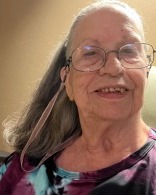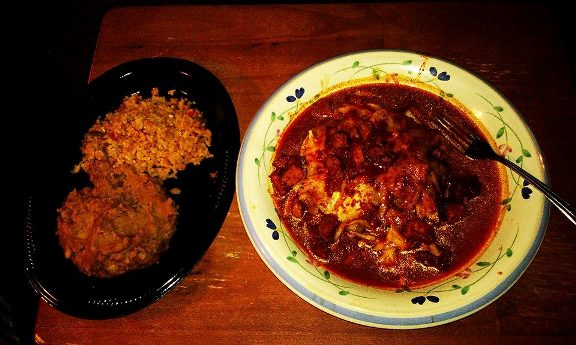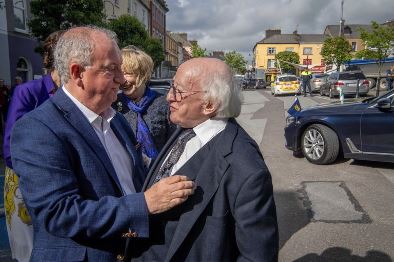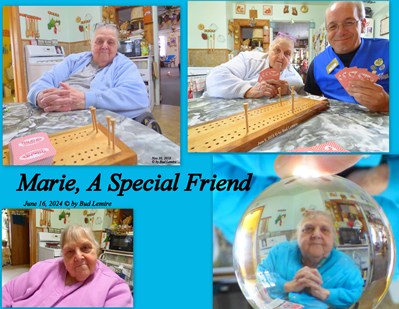
By
Melinda Cohenour
The Cohenour Line
Chapter 2, Encore
Research continues in connection with my husband’s
Cohenour line. The earliest ancestor to have used any form of the
surname that has evolved into COHENOUR (as we prefer) was Basthli
Sebastian Gachnouwer, born in 1543 in Goch, Kleve, North
Rhine-Westphalia, Germany. From Wikipedia, we learn Goch is an archaic
name, originally spelled either Gog or the Dutch form, Gogh. “It is a
town in the district of Kleve, in North Rhine-Westphalia, Germany. It is
situated close to the border with the Siebengewald in Netherlands,
about 7 miles south of Kleve and 17 miles southeast of Nijmegen.”
Further,
“Goch is at least 750 years old: the earliest mention of Goch is in a
document dated 1259. It was a part of the duchy of Cleves. During World
War II, the city was completely destroyed by Allied bombers during
Operation Veritable.” All of this leading up to the family belief that
the Gochenour-Cohenour name (in all its many permutations) derives from
its earliest ancestor residing in this ancient town. One of the
oft-repeated tales about how the surname evolved is that “Goch” referred
to “Hill” and that Gochen were people who lived on the hill, and that
Gochenour were people who had lived on the hill but were now Gone From
The Hill. We find that Goch in German; however, refers to a bog, a fen, a
marsh, or similar low-lying body of water. Goch, the ancient village,
was close to Kleves (originally Cleves) where the duchy of Cleves held
sway. The ancient castle there is the Schwanenburg Castle. Wikipedia
informs us: “The Schwanenburg Castle, where
the dukes of Cleves resided, was founded on a steep hill. It is located
at the northern terminus of the Kermisdahl where it joins with the
Spoykanal, which was previously an important transportation link to the
Rhine. The old castle has a massive tower, the Schwanenturm 180 feet (55
m) high, that is associated in legend with the Knight of the Swan,
immortalized in Richard Wagner's Lohengrin.
Medieval Kleve
grew together from four parts – the Schwanenburg Castle, the village
below the castle, the first city of Kleve on Heideberg Hill, and the
Neustadt ("New City"), dating from the 14th century. In 1242 Kleve
received city rights. The Duchy of Cleves, which roughly covered today's
districts of Kleve, Wesel and Duisburg, was united with the Duchy of
Mark in 1368, was made a duchy itself in 1417, then united with the
neighboring duchies of Jülich and Berg in 1521, when John III, Duke of
Cleves, married Mary, heiress of Jülich-Berg-Ravenburg. Kleve's most
famous native is Anne of Cleves (1515–1557), daughter of John III, Duke
of Cleves and (briefly) wife of Henry VIII of England. Several local
businesses are named after her, including the Anne von Kleve Galerie.”
All this makes me wonder if the early
Gochenour folks lived upon another hill, similar to and nearby the one
that housed the Schwanenburg Castle?
This column, though, is devoted to
tracking the line of descent from Basthli Sebastian Gachenouwer to my
dear husband, Roderick William Cohenour. It has not been an easy task as
the documents (if they exist at all) are not accessible through
Ancestry or any other typical website. It has been an arduous task to
seek out family histories and your author is forever grateful for the
work that has gone before by family researchers. In our following
reports, we shall delve into the stories that highlight this proud line
of Cohenours from Goch, Germany in 1543 to California, United States in
1945. This, then, is the result of our initial attempts to verify the
direct line ancestors.
First Generation: 10th Great-Grandfather
Basthli Sebastian Gachnouwer, born 1543, date of death
unknown, 10th great grandfather of my husband. Sebastian married
Adelheit Heidi Huber (b. 1538) in Goch. Their known children were Anna,
Sebastian II, and Jorg (George) Gachnouwer (1569-1610).
Second Generation: 9th Great-Grandfather
Jorg (George) Gachnouwer (1569-1610) wed Maria Weber on
13 Jul 1589 in Fischenthal, Zürich, Switzerland. This couple had a son
named JACOB (also called Hans Jagli) GACHNOUWER whose date of birth is
not known but whose baptism was recorded 28 Jul 1605 in Fischenthal,
Zürich, Switzerland.
Third Generation: 8th Great-Grandfather
(Hans) Jacob (Jagli) Gachnouwer (abt 1605-1685) married
Margaretha Peter on 26 May 1624 in Zürich, Switzerland, born 1601 in
Stralegg (which, presumably gives rise to her complicated naming in most
of the family history volumes as Elsbeth Margretha Petter der Stralegg
(Petter from Stralegg). Jacob was the first of the family to convert to
Anabaptism (later Mennonite), after his marriage. His wife’s family was
one of the early converts. Jacob would pay a high price for his faith,
stripped of all belongings, his children removed, his wife exiled, while
he spent years in a dank prison as punishment for his religious
beliefs.
Fourth Generation: 7th Great-Grandfather
Jacob and Margaretha’s son Heinrich Peter Der Stralegg Gachnauwer
(baptized 30 Apr 1631) was but one of their children to be removed from
the home and placed with “responsible community members” while their
father languished in prison. It is known Heinrich wed, but the name of
his wife is lost to posterity. The following notes have been recorded
for Heinrich:
NOTES: Birth recorded in Fischenthal
Church Register April 30, 1631; Heinrich, Jacob Gachnouwer "on the hill"
and Margaretha Peter, Anabaptists, had a son baptized. Sponsors;
Heinrich Schoch, "Weibel", said to be a low public official and Adelheit
Zuppinger, who is Joe Furrer's legitimate wife.
Heinrich Gachnauwer who was
baptized on April 30, 1631 in the parish of Fischenthal is the only
family member known to have survived the slaughters that took place in
Alsace, France, about 1670-1680. He relocated in the city of Heidelberg,
Germany.
In the Palatine Mennonite
Census lists, Heinrich is listed with eight children in 1685. the list
of his children has not been found, but this record is based on a list
project by Dwayne Coughenour, San Antonio, TX.
1643 Heinrich, about twelve
years old, was placed as an apprentice with a tailor, Fred Issler, who
was to received payment of 50 Taler from the State, plus a gratuity to
his wife, for three years during his Father's imprisonment in Othenbach
Convent Prison.
Fifth Generation: 6th Great-Grandfather
Joseph Gochnauer, Sr. (sometimes Christian is added as
his second given name), the son of Heinrich, born somewhere between 1698
and 1704, depending upon the resource) is the Immigrant Ancestor of our
line. His identification is made difficult as it appears Heinrich named
two sons Joseph with birth and death dates either obscured or
researchers have created a duplicate record. At this point, your author
has not clarified that fact. Thus, we shall use the data that appears
factual. Joseph married at least two times and, perhaps, three although
the documentation for that third marriage will need to be researched
more completely. Wed to Elsbeth (Elizabeth) Naff (Neff), they named a
son Joseph Christian Gochnauer II.
Sixth Generation: 5th Great-Grandfather
Joseph Christian Gochnauer II (1726-1763) married Mary
Magdalena Neff in January of 1757. They had three children, the eldest
being Henry Neff Cohenour. Family legend indicates this Joseph was
killed by an Indian’s arrow while working his fields.
Seventh Generation: 4th Great-Grandfather
Henry Neff Gochnauer (1754-1787) was born and met his
death in Hempfield, Lancaster County, Pennsylvania. Henry also spelled
his name Coghenour, the earliest mutation in the surname that would
morph into Cohenour. He and wife, Magdalena Fulwiler, were married in
1783, just four short years prior to Henry’s death. They had three
children, the eldest son being John born 25 Aug 1784. (Their daughter
Elizabeth Coghenour married Jacob Neff, one of several of these two
families’ intermarriages.)
Eighth Generation: 3rd Great-Grandfather
On 14 Nov 1805, John Kochenauer (also often spelled
Cohenour) married Dorothea Ellen Lorentz at the First Reformed Church,
Hempfield Township, Lancaster, Pennsylvania. This couple had ten
children, the third in line named Jacob Neff Cohenour.
Ninth Generation: 2nd Great-Grandfather
Jacob Neff married three times, the third wife, Sarah
Jane Layton, was widowed within months of giving birth to their first
surviving child, Elmer Layton Cohenour. Sarah’s husband died 15 Nov
1868. Little Elmer Layton Cohenour had been born 5 Mar 1868. Sarah had
not long to live. By the time Elmer was three years old, his mother had
also passed, leaving the care and custody of Elmer to her sister,
Clementine.
Tenth Generation: Great-Grandfather
Elmer Layton Cohenour married Martha Jane Lauterbach
(Louderback) 30 Oct 1890 in Fairbury, Jefferson County, Nebraska. This
couple would have three daughters and two sons, the first in line being
Leo Bertram Cohenour, my husband’s Grandfather.
Eleventh Generation: Grandfather
Leo Bertram Cohenour served in World War I as a
Lieutenant, J. G. in the Navy. He was a physician and surgeon. He
married Anneffiel Ethel Ann Warner 2 Aug 1917. They had two sons, the
second William Edward Cohenour.
Twelfth Generation: Father
William Edward Cohenour served in the Navy as a surgeon
and physician during World War II. He married Suzanne Cecilia Miller on
10 Sep 1944 in Denver, Colorado. There were four children born to this
marriage: Roderick William, Christopher Kent, Suzette Cecilia, and
Patricia Ann (Patti). Dr. Cohenour continued his practice until his
death 10 March 1982.
Future columns will update the research into
this family line, clarify where possible the multiple marriages and
numerous children reported by various sources, and – most importantly –
provide some of the stories that make this Cohenour family’s history so
colorful.
Click on the author's byline for bio and list of other works published by Pencil Stubs Online.
This issue appears in the ezine at www.pencilstubs.com and also in the
blog www.pencilstubs.net with the capability of adding comments at the
latter.

























